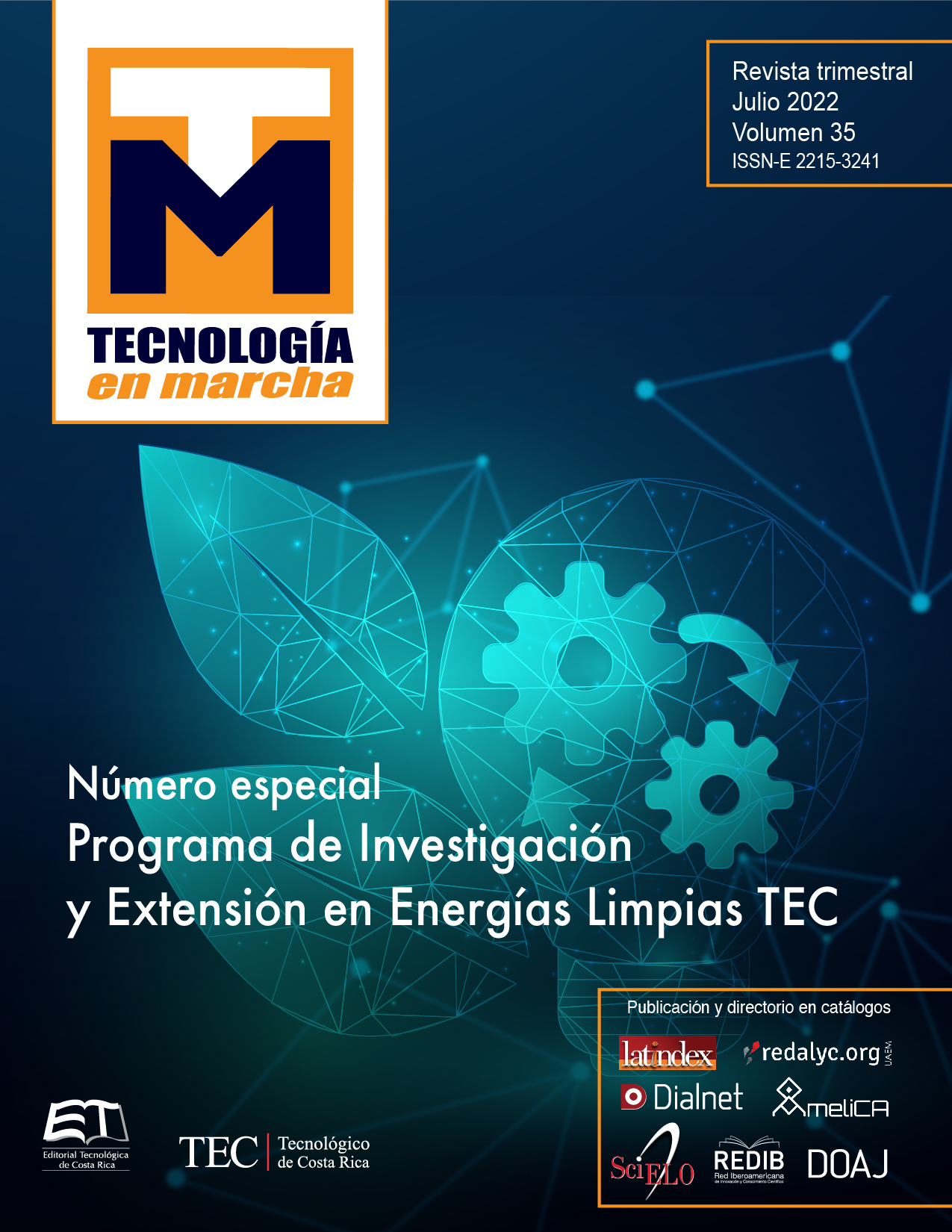Methodological proposal for energy biomass market characterization, the case of the Costa Rican rice
Main Article Content
Abstract
Energy production is commonly linked to high environmental costs. The agri-food sector is considered one of the most unbalanced sectors of the economy regarding energy intake and output; however, it also entails opportunities for cleaner energy production. Within such kind, the interest in bioenergy has grown; therefore, this study had the aim to propose a methodological framework for the characterization of the energy biomass market. The proposal uses methods such as literature reviews, surveys and statistical analysis. As a result, the proposed framework consists of the following steps: a) sector data collection, including technical biomass parameters, b) evaluation of the degree of knowledge of the market actors in regards to those parameters, c) the analysis of the perception of the actors in regards to the energy biomass market, and d) the definition of variables affecting the energy biomass market. The framework was applied to the Costa Rican rice agri-food chain as a case study and validation process. Potentially, 1.217.544 t of rice biomass obtained annually from husk and plant residues is fit for energy production. Moreover, the actors show relevant knowledge of technical parameters, perceive the market as stable, and define the volume and biomass homogeneity as determinant market variables. The obtained information is considered of interest for adequate market characterization and further strategic planning for bioenergy production.
Article Details

This work is licensed under a Creative Commons Attribution-NonCommercial-NoDerivatives 4.0 International License.
Los autores conservan los derechos de autor y ceden a la revista el derecho de la primera publicación y pueda editarlo, reproducirlo, distribuirlo, exhibirlo y comunicarlo en el país y en el extranjero mediante medios impresos y electrónicos. Asimismo, asumen el compromiso sobre cualquier litigio o reclamación relacionada con derechos de propiedad intelectual, exonerando de responsabilidad a la Editorial Tecnológica de Costa Rica. Además, se establece que los autores pueden realizar otros acuerdos contractuales independientes y adicionales para la distribución no exclusiva de la versión del artículo publicado en esta revista (p. ej., incluirlo en un repositorio institucional o publicarlo en un libro) siempre que indiquen claramente que el trabajo se publicó por primera vez en esta revista.
References
CNFL, “Foro “Desafíos de la Innovación en el Servicio Eléctrico Solidario”,” https://fb.watch/5bI83V0tXR/, San José, 2021.
S. Medina and A. Venegas, “Energías Renovables. Un futuro óptimo para Colombia,” Revista Punto de Vista, vol. 9, no. 13, p. 47–62, 2018.
D. Hoehn, M. Margallo, J. Laso, I. García-Herrero, A. Bala, P. Fullana-i-Palmer, A. Irabien and R. Aldaco, “Energy Embedded in Food Loss Management and in the Production of Uneaten Food: Seeking a Sustainable Pathway,” Energies Volume 12 (4), pp. 767, doi:10.3390/en1204, 2019 .
ONU, “El papel futuro de la iniciativa “Energía Sostenible para Todos” en la promoción de la energía sostenible,” 2017.
A. Beames, J. Goedhart and A. Kanellopoulos, “Biobased Economy: Critical Foundation for Achieving Sustainable Development Goals,” Decent Work and Economic Growth. Encyclopedia of the UN Sustainable Development Goals., 2019.
J. Fernández, F. Gutiérrez, P. Del Rio, G. San Miguel, A. Bahillo, J. Sánchez, M. Ballesteros, J. Vázquez, L. Rodríguez and J. Aracil, Tecnologías para el uso y transformación de biomasa energética, Madrid, España: Ediciones Mundi-Prensa, 2015.
F. Nogués, D. García and A. Rezeau, Energía de la Biomasa (volumen I), Zaragoza, España: Prensas Universitarias de Zaragoza, 2010.
UNEP, “Visión global de los Residuos Agrícolas Orgánicos para su aprovechamiento energético,” DTIE, UNEP, IETC, 2013.
Instituto Costarricense de Electricidad, “Plan de expansión de la generación eléctrica 2016-2035,” GrupoICE, San José, Costa Rica, 2017.
Grupo ICE, “Somos electricidad renovable y solidaria,” 2020. [Online]. Available: https://www.grupoice.com/wps/wcm/connect/7a3172c0-b703-4bbf-9d61-b363e822f1c1/Fasciculo_Electricidad_2020_compressed.pdf?MOD=AJPERES&CVID=m.pLjj8.
D. Zárate and R. Ramírez, “Matriz Energética de Costa Rica Renovabilidad de las fuentes y reversibilidad de los usos de energía,” Fundación Friedrich Ebert (FES), San José, Costa Rica, 2016.
IICA-UCR-MAG, “Simposio. Una visión del sector agropecuario basada en el CENAGRO 2014,” San José, Costa Rica, 2016.
J. C. Valverde, D. Arias, R. Campos, M. F. Jiménez and L. Brenes, “Análisis perceptual del mercado energético basado en biomasa lignocelulósica de origen arbóreo en Costa Rica,” Madera y bosques, 26(3), e2632066. , p. https://doi.org/10.21829/myb.2020.2632066, 2020.
S. Nepal, L. T. Tran and D. G. Hodges, “Determinants of Landowners’ Willingness to Participate in Bioenergy Crop Production: A Case Study from Northern Kentucky,” Forests 11, no. 10, p. 1052. https://doi.org/10.3390/f11101052, 2020.
CONARROZ, “Informe Estadístico Periodo 2014-2015,” 2016. [Online]. Available: http://www.conarroz.com/index.php/en/industria. [Accessed 20 Abril 2020].
SEPSE, “Actualización de la encuesta de biomasa como insumo para su incorporación en la matriz energética de Costa Rica,” 2018. [Online]. Available: https://sepse.go.cr/. [Accessed 20 Abril 2020].
IEA, World Energy Outlook 2018, Paris, France: International Energy Agency, 2019.
Ministerio de Ambiente y Energia, “VII Plan Nacional de Energía 2015-2030,” MINAE, DSE, PNUD, San José, Costa Rica, 2015.
FAO, “La Bioenergía en América Latina y El Caribe. El estado de arte en países seleccionados.,” Organización de las Naciones Unidas para la Alimentación y la Agricultura, Santiago, Chile, 2013.

